1 A) law of conservation of energy B) law of conservation of mass C) law of conservation of mass D) ideal gas law 2 <a onClick="window.open('/olcweb/cgi/pluginpop.cgi?it=jpg::::/sites/dl/free/007874637x/514762/fig9_4.jpg','popWin', 'width=NaN,height=NaN,resizable,scrollbars');" href="#"><img valign="absmiddle" height="16" width="16" border="0" src="/olcweb/styles/shared/linkicons/image.gif"> (18.0K)</a> A) Aqueous aluminum and bromine gas react to produce solid aluminum bromide. B) Solid aluminum and aqueous bromine react to produce solid aluminum bromide. C) Solid aluminum and bromine gas react to produce solid aluminum bromide. D) Aqueous aluminum and bromine gas react to produce aqueous aluminum bromide. 3 2(g) ?(s) + O2(g) → Fe(2) O3(s) A) 2 B) 3 C) 4 D) 5 4 2 A) synthesis reaction B) decomposition reaction C) single-replacement reaction D) double-replacement reaction 5 <a onClick="window.open('/olcweb/cgi/pluginpop.cgi?it=jpg::::/sites/dl/free/007874637x/514762/fig9_13.jpg','popWin', 'width=NaN,height=NaN,resizable,scrollbars');" href="#"><img valign="absmiddle" height="16" width="16" border="0" src="/olcweb/styles/shared/linkicons/image.gif"> (22.0K)</a> A) 2Fe(s) + Al2 O3(s) → Fe2 O3(s) + 2Al(s) B) 2Al(s) + Fe2 O3(s) → Al2 O3(s) + 2Fe(s) C) 3Fe(s) + 2Al2 O3(s) → 3Fe2 O3(s) + 2Al(s) D) 3Al(s) + Fe2 O3(s) → 3Al2 O3(s) + 2Fe(s) 6 2 O2 , changes in the presence of a catalyst in the following reaction. What type of chemical reaction is this?2 O2(aq) → 2H2 O(l) + O2(g) A) synthesis reaction B) combustion reaction C) decomposition reaction D) single replacement reaction 7 3 (aq) → AgCl(s) + HNO3 (aq)A) HCl(aq) B) AgNO3 (aq) C) AgCl(s) D) HNO3(aq) 8 A) an acid B) a base C) a gas D) water 9 O + KCl(aq)A) Cl- (aq) + OH- (aq) → ClOH(aq) B) H+ (aq) + K+ (aq) → HK(aq) C) Cl- (aq) + K+ (aq) → KCl(aq) D) H+ (aq) + OH- (aq) → H2 O(l) 10 <a onClick="window.open('/olcweb/cgi/pluginpop.cgi?it=jpg::::/sites/dl/free/007874637x/514762/fig9_21.jpg','popWin', 'width=NaN,height=NaN,resizable,scrollbars');" href="#"><img valign="absmiddle" height="16" width="16" border="0" src="/olcweb/styles/shared/linkicons/image.gif"> (110.0K)</a> A) HCO3 - + H+ → CO2 (g) + H2 O(g) B) HCO3 - + H+ → H2 O(l) C) HCO3 - + H+ → CO2 (g) + H2 O(l) D) HCO3 - + H+ → CO2 (g)





